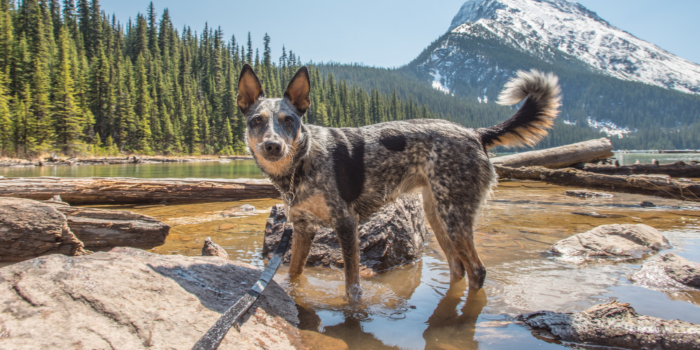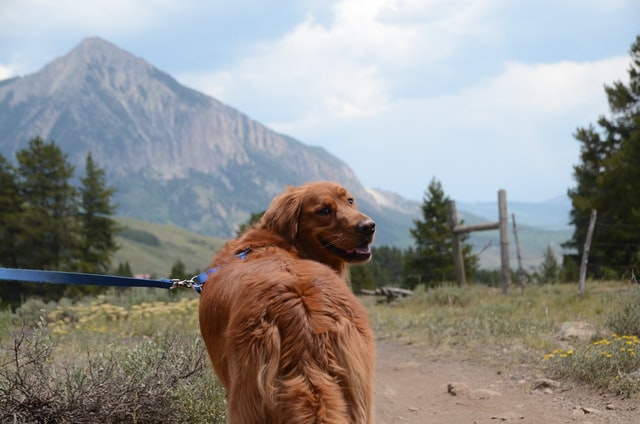In the last episode of Season One of the Paws & Reward podcast, I interview Amber Quann of Summit Dog Training in Fort Collins, CO, and Charissa Carvell of Alpine Behavior and Training in Glenwood Springs, CO about preparing your dog for the great outdoors! If you’re wondering how to start hiking with your dog, this is the episode for you!
This is one of my favorite topics since I fell in love with hiking with dogs and being outside through my dog Sully. We discuss why taking our dogs out in nature is important, what skills we should teach our dogs to be safe while on the trail, and how being in the moment can strengthen the human-canine bond.
Before we explored how to start hiking with your dog and spend more time outdoors, we talked about why spending time in nature is so valuable.
Why is getting your dog outside in nature so important? For both humans and dogs.
Getting outside is an important aspect of mental health. Scientific studies have shown that being out in nature, breathing fresh air, decompressing, allowing our dogs to sniff, all have positive impacts on our health and well-being.
Moving the body freely and being away from technology helps us connect with our dogs and be more present.
Seeking out new adventures is a catalyst for building the human-canine bond with our dogs. Working on skills and building a good connection can cause big impacts in all other aspects of our lives.
Practicing dog training techniques and behavior management only in sterile, controlled environments, like at home, isn’t going to cultivate that robust relationship or resilience we need while out in the world.
Pro Tip:
Adjusting to your dog’s needs while they age is important as well, even if you’re just beginning to explore how to start hiking with your dog. It can be a challenge to accept that your dog is aging and not capable of doing the same things as before, but the bond can still be strong. Sully reminds me to slow down in nature and to be more in the moment.
How to Start Hiking With Your Dog: Things to Consider When Choosing Location
Getting outside and hiking with dogs is not as simple as heading to a local trail and going for a walk. There are many things to consider to ensure that your time in nature is safe and fun for you and your dog.
- For a reactive dog, choosing a place that’s far away from other dogs and people is essential for decompression.
- Finding places that have water availability during the summer.
- Looking for places that make you, the human, feel safe is very important.
- Taking into consideration the time of day, especially in the extremes of winter or summer.
- Legality: Check your trails before you go, do the dogs need to be leashed? Are dogs allowed? There may be specifications as to the length of leash permitted. Make sure to pick up after your dog, follow the guidelines for the trails you frequent and be respectful and mindful of others on the trail.
If you’re exploring how to start hiking with your dog, remember that the great outdoors is a great environment to work on training techniques and connect more fully with your dog. When choosing a location, think about what environment will best help your dog rehearse the behaviors you want.
Be aware of certain distractions like wildlife or people and alter the time of day or the location. If you have a reactive dog, or one with high prey drive, or an overly-friendly social butterfly, be prepared to spend the entire hike managing your dog.
If that’s not the hike you want, then plan to go earlier in the day or rearrange the environment in other ways to help your dog be successful at their current training level.
How to Start Hiking With Your Dog: Choosing The Right Equipment
Having the right equipment when you’re exploring how to start hiking with your dog is another important part of getting outdoors with your furry friend. The right equipment can mean the difference between a fun, connected walk or a stressful experience for you and your dog.
- Back Clip Harness: clip the leash to the rear of the harness to allow free movement. If you have pulling or control concerns then other equipment might work better for you. But if we are training our dogs and helping them learn appropriate behaviors and we feel we can do the trail successfully then a body harness is best.
- A Long-Line: Anywhere from 10-30 feet, personal preference.
- Identification: Collar, ID tag, microchip are all essential as well.
- Bell attached to the harness: Good for warning wildlife and for small dogs it helps the human know where they are quickly and easily. Tip: Use Christmas bells from craft stores and carabiners to keep the bells attached even if your dogs rub against trees. The velcro ones can fall off easily.
- Backpack for carrying smaller dogs: Especially if they are young and growing, or older and slowing down.
- A Shorter Leash (4-6 ft): Can be good to have if you plan to practice off-leash recall but are still new to practicing and don’t quite trust your dog to be completely off leash. A shorter leash is also helpful for more crowded areas.
- Water for you and your dog: The water on the hike may not be best for your dogs to consume. Dogs will be dogs, but if we have clean water for them and provide it often, they’re less likely to drink large amounts of water found in nature.
- Reinforcement for the dogs: Whether that’s food or toys, whatever you need to reinforce good choices on or off leash.
- Bear spray: Very important if you are in bear country.
- Optional: GPS Collar: A great extra tool for peace of mind. It can also be fun to see where your dogs go on their own.

What are your favorite skills to teach the dog while outdoors?
Wondering how to start hiking with your dog in a way that supports their training and behavior management? These are some of the best skills to teach and practice while enjoying the great outdoors.
- Recall (come when called). Practice an individual recall for calling one dog at a time. With multiple dogs a group recall like “Puppies!” is essential for off-leash time.
- Stay with me – make sure to reward consistently to keep them close.
- A release cue (Example: “All done”) to go enjoy the trail and do what they want. This is important for all behaviors to have a release cue. Whenever it’s to keep your dog close to you or during a down/stay. A release is essential to let your dog know they can go do their own thing.
- Sit/Down basics to help cool down your dog.
- Stay with distractions and duration until released.
- Wait by/in the car while you get ready for the hike (usually giving lots of cookies/reinforcement).
- Crate training (with ample reinforcement) after the hike is completed to be able to jump into the crate happily.
Try not to reinforce the high arousal behaviors while driving to the trail. Create “no big deal” experiences. Drive to the trail or park, sit in the car until the dog is calm. Be boring to help your dog. We don’t want driving and parking to be this high-energy event. Instead, creating these “no big deal” experiences help reinforce calmer behavior and then create a more successful hike with your dog.
How do you manage multiple dogs while hiking?
Learning how to start hiking with your dog can feel even more overwhelming if you have more than one dog. But it’s totally possible to spend fun and safe time outdoors with multiple dogs.
Individual name recognition is essential. When I name you, you get a treat. Being able to share reinforcement without being grumpy about not receiving a treat when the other dog does is an important skill to develop.
Each dog may have different hiking styles, some might want to stay close and others might want to run wild. Consider the dynamic between dogs. Find ways to use the cues they know to facilitate a safe and fun experience for all involved. A GPS collar helps to know where each dog is at any given time.
It’s also important to understand that you won’t be training harder behaviors when the dogs are together on the trail. Train in low distraction areas and then work up to the trail environment.
Think intentionally and teach behaviors that are resilient and don’t require us to be physically right beside the dog for that behavior to occur. We want to remove physical cues quickly so they can be successful at a distance.
Pro Tip:
You don’t have to bring all the dogs to the trail at once – especially if you’re just learning how to start hiking with your dog. It’s okay to leave one or two at home to create the type of hike that’s best for each individual. Quality time can be so important and if you’re just beginning to explore how to start hiking with your dog, bringing one at a time could be a good transition.
Want more resources on how to start hiking with your dog?
Explore Amber’s website for more resources & training on hiking with dogs and enjoying the great outdoors with your pet.
- Summit Dog Training
- Check out Amber’s awesome online classes and register today!
- Alpine Behavior and Training
Worried about bringing a reactive dog outdoors? These resources for reactive pet parents from Paws & Reward can help:
- Podcast Episode #18: Leash Reactivity in Dogs
- Podcast Episode #30: Real Behavior Change for Reactive Dogs
- Article: How to Walk a Reactive Dog

